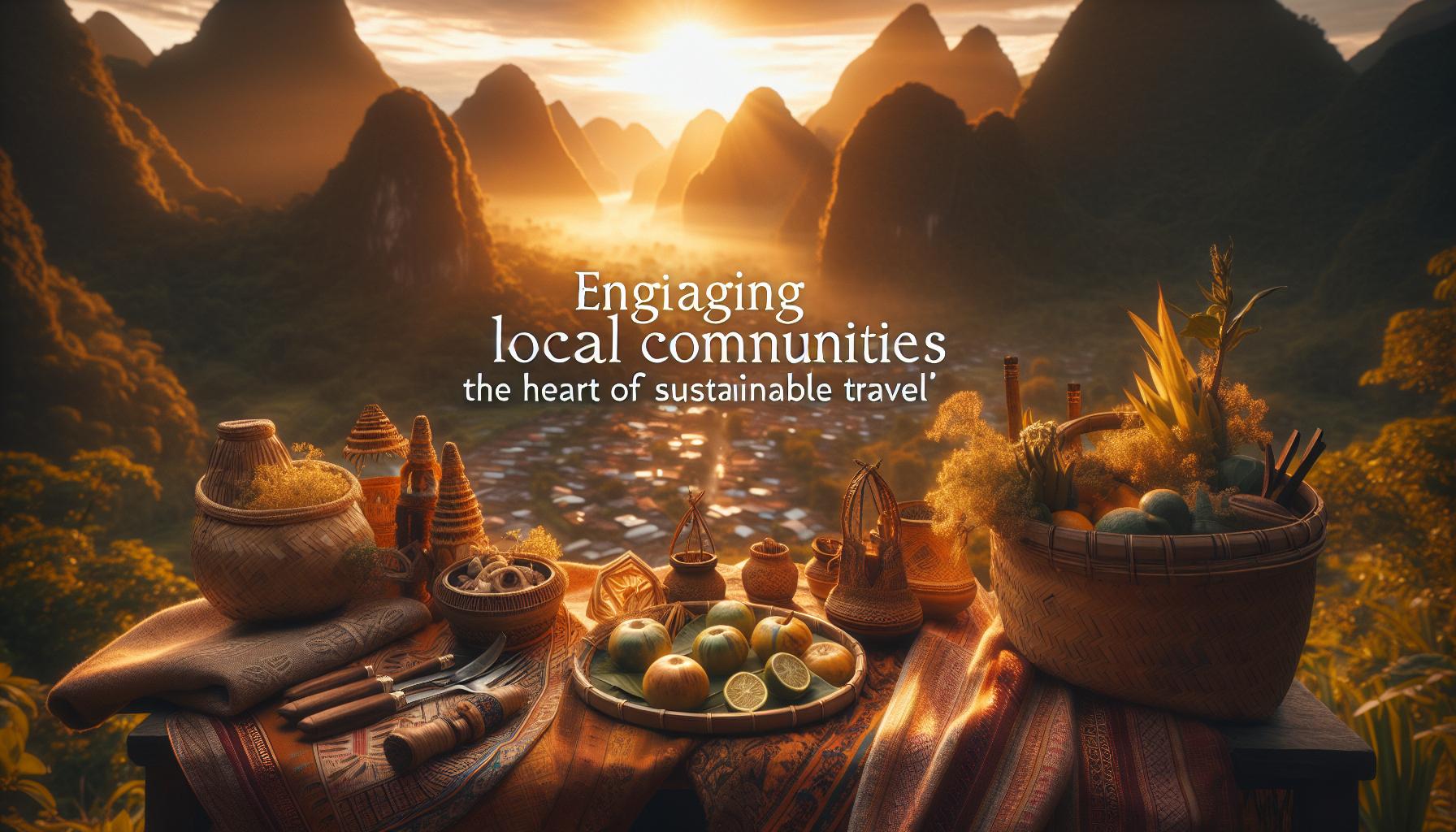Amidst global concerns over environmental degradation and biodiversity loss, Ecuador stands out as a beacon of hope, showcasing how lasting practices in tourism can foster conservation. by prioritizing eco-friendly initiatives, the country not only protects its rich ecosystems but also enhances the travel experience, making sustainability a vital part of its identity.
Understanding the Concept of Sustainable Tourism in Ecuador
Embracing Sustainable Practices in Ecuador’s Tourism
Ecuador stands as a beacon for sustainable tourism,notably due too its rich biodiversity and the commitment of various stakeholders to embrace practices that benefit both the environment and local communities. In a country known for its remarkable landscapes—from the Amazon rainforest to the majestic Andes mountains—sustainable tourism serves as a vital tool for preserving these natural wonders while boosting local economies. This dynamic approach not only nurtures the diverse ecosystems but also engages visitors in meaningful experiences that highlight the importance of ecological stewardship.
Key Principles of Sustainable Tourism
Sustainable tourism in Ecuador revolves around several core principles that ensure a healthy balance between tourism development and environmental preservation. These include:
- Community Engagement: Involving local communities in tourism planning and decision-making helps ensure that their needs and values are respected,fostering a sense of ownership and pride.
- Conservation of Biodiversity: Many tour operators prioritize ecological conservation,implementing practices that protect endangered species and fragile ecosystems.
- Responsible Resource Management: Sustainable tourism promotes efficient use of resources, reducing waste and minimizing environmental impact.
- Cultural Respect: Tourists are encouraged to respect local cultures, traditions, and customs, enhancing the overall travel experience while supporting cultural heritage.
Real-world Examples of Sustainable Tourism in Action
Several initiatives showcase Ecuador’s model for sustainable tourism, particularly in regions such as the Galápagos Islands and the amazon. As an example, local eco-lodges employ sustainable practices such as using solar energy, composting waste, and sourcing food locally. These efforts not only reduce carbon footprints but also foster community development by creating jobs and supporting local economies.
Moreover,some tour operators offer packages that educate visitors about the unique biodiversity of the region while actively contributing to conservation projects. Travelers can participate in tree-planting activities or wildlife monitoring programs, turning their vacations into a means of impactful environmental engagement.
| Initiative | Description | Impact |
|---|---|---|
| Eco-Lodging | accommodations that utilize renewable energy and local resources. | Reduces carbon footprint and supports local economies. |
| Community-Based Tours | Tour packages led by local guides that engage visitors in cultural experiences. | Empowers local communities and preserves cultural heritage. |
| Conservation Efforts | Programs that involve tourists in wildlife preservation activities. | Enhances biodiversity conservation and promotes environmental awareness. |
Through these principles and examples, Ecuador exemplifies how sustainable tourism can be effectively integrated into a nation’s economic fabric, ensuring that natural resources are preserved for generations while providing enriching experiences for visitors. In embracing this model, Ecuador continues to set a standard for responsible travel that resonates worldwide.
The Role of Biodiversity in Ecuador’s Eco-Tourism Strategy
Did you know that Ecuador is home to an amazing 10% of the world’s known biodiversity? This incredible variety includes not only an notable array of flora and fauna but also unique ecosystems such as the Amazon rainforest, the Andes mountains, and the Galápagos Islands. This rich biodiversity serves as a cornerstone for the country’s eco-tourism strategy, driving sustainable practices that benefit both conservation efforts and local communities.
The Significance of Biodiversity in Ecuadorian eco-Tourism
Ecuador’s biodiversity is not just a backdrop for tourism; it is an essential component that enhances the travel experience while promoting environmental stewardship.Visitors are drawn to the lush landscapes and the opportunity to observe wildlife in its natural habitat. By integrating biodiversity into eco-tourism initiatives, Ecuador can:
- Promote conservation Awareness: Tourists become advocates for conservation when they engage firsthand wiht the diverse ecosystems, understanding the importance of protecting them.
- Generate Economic Benefits: Eco-tourism activities create jobs and generate income for local communities, encouraging them to participate in conservation efforts.
- Support Local Cultures: This form of tourism allows for the preservation of indigenous cultures, as local communities share their knowledge about traditional practices and the natural world.
- Enhance research Opportunities: Biodiversity hotspots attract researchers and conservationists who contribute to ongoing studies and help develop more effective conservation strategies.
Real-World Applications: Eco-Tourism Programs in Action
Ecuador has been proactive in implementing eco-tourism programs that successfully utilize its rich biodiversity. An excellent example is the Yasuni National Park in the Amazon Basin, where visitors can experience guided tours that emphasize the region’s unique flora and fauna while promoting responsible travel practices. These tours frequently enough include stays at eco-lodges that are designed to minimize environmental impact and incorporate sustainable energy sources.
Another noteworthy program is the Galápagos Islands’ sustainable tourism initiative, which limits the number of visitors and utilizes local guides who are experts in wildlife conservation. Such practices ensure that tourism activities do not disrupt the delicate ecosystems of the islands,while also providing economic opportunities for local residents.
| Eco-Tourism Benefits | Examples in Ecuador |
|---|---|
| Conservation Awareness | Guided wildlife tours in Yasuni |
| Job Creation | Eco-lodges run by local communities |
| Cultural Preservation | Indigenous community engagement in the Amazon |
| Research Opportunities | Studies conducted in the Galápagos Islands |
Utilizing biodiversity as a key factor in eco-tourism not only supports the environment but also empowers local communities, reinforcing Ecuador’s reputation as a leader in sustainable tourism. By fostering a deeper understanding of its natural wealth, the nation not only attracts tourists but also inspires them to become stewards of the planet.
Engaging Local Communities: the Heart of Sustainable Travel
Empowering Communities for Lasting Change
In the heart of the Amazon rainforest, local communities play a crucial role in maintaining the delicate balance between tourism and biodiversity. Sustainable Tourism Ecuador: A Model for Biodiversity conservation in Action emphasizes that engaging these communities is not just beneficial; it is indeed essential. When local residents are included in tourism efforts, they become stewards of their environment, leading to improved conservation outcomes and enhanced cultural heritage preservation. Studies show that when communities benefit directly from tourism,they are more likely to protect their natural surroundings.
Methods of Engagement
Engaging local communities can take various forms, and adopting collaborative tourism models is one effective strategy. These include:
- Cooperative ventures: Involving locals in planning and management.
- Training programs: Providing education on sustainable practices and buisness skills.
- Involvement in cultural exchanges: Encouraging interaction between tourists and local traditions.
- Regular consultation: Ensuring ongoing dialog between stakeholders to address concerns and adapt strategies.
By implementing these methods, local communities gain ownership over their resources, leading to sustainable economic development and a stronger commitment to conservation.
Real-world Examples
An exemplary case is the way Ecuador’s indigenous groups collaborate with tour operators to create immersive experiences that highlight their culture and biodiversity. For instance, in the Yasuni National Park, indigenous communities have developed guided tours that educate visitors about their way of life while protecting their lands from exploitation. This not only leads to increased visitor satisfaction but also fosters a deeper understanding of the importance of preserving biodiversity.These initiatives demonstrate that when local communities thrive economically and socially from sustainable tourism practices, they can effectively contribute to biodiversity conservation, making Sustainable Tourism Ecuador: A Model for Biodiversity Conservation in Action not just a concept but a transformative reality.
| Community Engagement Strategies | Benefits |
|---|---|
| Cooperative ventures | Enhanced resource management |
| Training programs | Improved local skills |
| Cultural exchanges | Stronger cultural pride |
| Regular consultation | adaptation of tourism strategies |
Engaging local communities is therefore central to sustainable travel initiatives, exemplified in Ecuador through collaborative efforts that marry tourism with conservation, ultimately fostering a model that other regions can replicate for their ecological and economic well-being.
Eco-Friendly Practices: How Tour Operators Are Making a Difference
Across the globe, the concept of eco-friendly tourism is not only reshaping the travel industry but also playing a crucial role in biodiversity conservation. Tour operators in Ecuador are pioneers in this field, showcasing how sustainable tourism can foster environmental preservation while enhancing the local economy. By embracing practices that prioritize eco-consciousness, these operators create a powerful model for sustainable tourism worldwide.
Community Engagement and Education
One of the key strategies employed by tour operators in Ecuador is engaging local communities and educating both visitors and residents about the importance of biodiversity.This is achieved through:
- Workshops and Guided Tours: Operators frequently host educational workshops that highlight local ecosystems and conservation efforts, fostering a deeper thankfulness among tourists.
- Involvement of Local Guides: Employing local guides not only boosts the economy but also ensures that visitors recieve authentic insights into the region’s biodiversity, cultural heritage, and conservation challenges.
Responsible Wildlife Tours
Operators in Ecuador have pioneered responsible wildlife tourism that minimizes disturbance to natural habitats. These practices include:
- Strict Guidelines: Tour groups are kept small to reduce the impact on wildlife and habitats, adhering to guidelines that protect sensitive areas.
- Wildlife Conservation Initiatives: Many operators collaborate with conservation organizations to support local wildlife protection initiatives, contributing a portion of tour fees directly to these causes.
Promoting Sustainable Practices
In their business operations, Ecuadorian tour operators implement sustainable practices that resonate throughout their excursions. For instance:
- Utilizing Renewable Energy: Some lodges powered by solar energy minimize their carbon footprint, demonstrating a commitment to sustainable operations.
- Reducing Plastic Waste: Tour operators actively encourage the use of reusable water bottles and bags, significantly cutting down on single-use plastic waste.
| Practice | description | Impact |
|---|---|---|
| Education Programs | Workshops for tourists and locals | Increased awareness and conservation support |
| Small Group Tours | Minimized visitor impact | Better wildlife observation |
| Sustainable Accommodations | Use of renewable energy sources | Lower carbon emissions |
By exemplifying these eco-friendly practices,tourists visiting ecuador can enjoy an enriching experience while contributing to the sustainable tourism model that serves as a benchmark for biodiversity conservation in action.
Highlights of Ecuador’s Natural Wonders: A Traveler’s Guide
Did you know that Ecuador is home to some of the highest levels of biodiversity in the world? This small South American country offers a stunning array of natural wonders that draw nature lovers and eco-conscious travelers alike. With its rich ecosystems, which include the Amazon rainforest, the Andes mountains, and the Galápagos Islands, Ecuador is a prime destination for those looking to experience the beauty of the planet while embracing sustainable tourism practices that prioritize conservation.
The Amazon Rainforest
Venture into the heart of the Amazon, where you can immerse yourself in one of Earth’s most diverse ecosystems. This vast, lush landscape is home to countless species, many of which are found nowhere else on the planet. Visitors can engage with local communities that practice eco-tourism, providing insights into indigenous lifestyles while contributing to the conservation of their environment. Look for lodges that implement sustainable practices, such as solar energy and waste reduction programs, ensuring your visit positively impacts this remarkable habitat.
The Andes Mountains
The majestic Andes invite travelers to experience breathtaking scenery and vibrant cultures. Trek through the stunning landscapes of national parks like the Cotopaxi and chimborazo, where the towering peaks are just as impressive as the varied wildlife. Engage in sustainable hiking tours that promote low-impact travel and educate you on the local flora and fauna. be sure to support community-led initiatives; purchasing handicrafts from local artisans not only enriches their economies but also fosters cultural preservation.
Galápagos Islands: A Unique Ecosystem
No exploration of Ecuador’s natural wonders would be complete without mentioning the galápagos Islands. Renowned for their unique species, including giant tortoises and marine iguanas, these islands are a living laboratory of evolution. Opt for tours led by certified naturalists who adhere to strictly regulated pathways to minimize ecological footprints. Consider sustainable activities like snorkeling with sea lions or hiking in designated regions to witness wildlife in their natural habitats while ensuring their preservation for future generations.
| Destination | Notable Wildlife | Sustainable Activities |
|---|---|---|
| Amazon Rainforest | Amazon river dolphin, poison dart frogs | Guided eco-tours, community visits |
| Andes Mountains | Andean condor, vicuña | Trekking with local guides, cultural exchanges |
| Galápagos Islands | Blue-footed booby, Galápagos penguin | Snorkeling, wildlife watching tours |
By emphasizing sustainable tourism practices on your travels, you not only enhance your own experience but also contribute to the ongoing effort to conserve ecuador’s invaluable natural resources. Whether you’re navigating the dense Amazon, scaling the peaks of the Andes, or discovering the unique wildlife of the Galápagos, each moment spent in this vibrant country supports a broader model for biodiversity conservation in action.
Responsible Wildlife Tourism: Protecting Ecuador’s Unique Species
Did you know that Ecuador is home to an astonishing 10% of the world’s biodiversity despite its small size? This rich tapestry of unique ecosystems supports countless species found nowhere else on Earth, making responsible wildlife tourism not just a possibility but a necessity for conservation efforts. By embracing sustainable practices, tourists can help protect Ecuador’s vital natural heritage while experiencing its unmatched beauty firsthand.
Understanding Responsible Wildlife tourism
Responsible wildlife tourism is about more than just witnessing nature; it’s about preserving it. to engage in effective wildlife tourism in Ecuador, consider the following principles:
- Respect Wildlife Habitats: Observe animals from a distance and avoid disrupting their natural behavior.
- Choose Eco-friendly tours: Support operators that prioritize environmental stewardship and local community engagement.
- Stay on Designated Paths: Reduce habitat disturbance by sticking to established trails and routes.
- Practice leave No Trace: Ensure you leave your surroundings as lovely as you found them; pack out all trash.
Such practices not only enhance the experience for tourists but also minimize negative impacts on wildlife and ecosystems.
Real-World Examples of Sustainable Practices
Several ecotourism initiatives in Ecuador serve as remarkable models for responsible wildlife tourism. As a notable example, the Yasuni National Park, one of the most biodiverse areas on the planet, offers guided tours that educate visitors on the delicate balance of its ecosystems. Here, tourists can learn about the indigenous cultures that have coexisted with nature for centuries.Additionally,community-led initiatives like those in the Galápagos Islands emphasize the importance of protecting local fauna and flora. By charging entrance fees that directly fund conservation projects, these programs ensure that the income generated from tourism directly benefits preservation efforts.
| Operation | Focus Area | Conservation Impact |
|---|---|---|
| Yasuni Eco-Guide | Wildlife Education | Funds local conservation programs |
| Galápagos National Park | Protecting Endemic Species | Restoration of natural habitats |
| Napo Wildlife Center | indigenous Community Development | Supports sustainable livelihoods |
Incorporating tourism into conservation strategies allows for a symbiotic relationship that benefits both the environment and the local communities. Visitors who make informed choices play a pivotal role in ensuring that Ecuador’s stunning biodiversity continues to thrive for generations to come. By adopting these sustainable tourism strategies, travelers not only enrich their experiences but contribute meaningfully to conservation in action, embodying the essence of ecuador’s sustainable tourism model.
Measuring Success: The Impact of Sustainable Tours on Conservation
did you know that Ecuador is home to more than 25,000 species of plants, 1,600 species of birds, and an astounding 350 species of mammals? As global awareness of environmental issues grows, sustainable tourism has become a cornerstone for biodiversity conservation in this biodiverse nation. The integration of responsible tourism practices has not only enriched the visitor experience but has also significantly impacted conservation efforts in Ecuador’s unique ecosystems.
Quantifying Conservation Benefits
The success of sustainable tourism in Ecuador can be measured through various indicators directly linked to conservation efforts. This includes the increase in protected areas, enhancement in local biodiversity, and greater community involvement. Such as, when eco-friendly tour operators encourage visitors to participate in wildlife monitoring or habitat restoration, they directly contribute to the preservation of critical habitats.
- Protected Areas: The establishment of new national parks and reserves has been supported by the revenue generated from sustainable tours.
- Biodiversity Resilience: Documented increases in animal populations, such as endangered species, serve as evidence of the positive impact.
- Community Engagement: Local communities are empowered and incentivized to protect their natural environment, fostering a sense of stewardship.
Real-World Examples
One prosperous initiative is the “Hummingbird Project,” which combines birdwatching tours with conservation funding. Tourists pay to participate in guided tours, with a portion of the proceeds allocated for habitat restoration projects. Data from the project indicates a notable increase in local bird populations, which serves as a tangible success story for sustainable tourism in Ecuador.
| Project Name | Impact on Biodiversity | Visitor Engagement |
|---|---|---|
| Hummingbird Project | Increase in local bird populations by 20% | 1,200 visitors participated in 2022 |
| andean Condor Conservation Tour | Rehabilitation of condor habitat | 800 visitors and counting |
| Amazon Wildlife Monitoring | Successful tracking of endangered species | 1,500 hours of volunteer participation |
Through sustainable tourism in Ecuador, visitors not only enjoy breathtaking landscapes and vibrant wildlife but also play a pivotal role in conservation. By measuring the tangible impacts of these eco-conscious endeavors, stakeholders can further refine and bolster initiatives that preserve the planet’s rich biodiversity, establishing Ecuador as a leading model in the global sustainable tourism movement.
Practical Tips for Travelers: How to Travel Sustainably in Ecuador
Did you know that Ecuador is home to 10% of the world’s biodiversity, despite covering only 0.2% of the planet’s landmass? This incredible natural wealth makes the country a hotspot for sustainable tourism, offering travelers a chance to experience its unique ecosystems while contributing to their preservation. To ensure that your visit to Ecuador leaves a positive impact, consider adopting the following practical tips for sustainable travel.
Choose eco-Friendly Accommodations
opt for lodgings that prioritize sustainability,such as those committed to environmental practices. Many eco-lodges in Ecuador focus on reducing waste, conserving energy, and supporting local communities. Look for certifications from recognized sustainable tourism organizations like Rainforest Alliance or the Ecuadorian Ministry of Tourism.
Support Local Communities
When exploring Ecuador, engage with local artisans, restaurants, and tour operators that reinforce the local economy. This approach not only enriches your travel experience but also fosters a sense of responsibility towards the communities you visit.
- Try to eat at local markets and family-run eateries.
- Buy handmade crafts from local artisans instead of mass-produced souvenirs.
- Choose guided tours offered by local companies that employ community members.
Limit Your Environmental Footprint
Every traveler has a role in conserving the environment. Simple actions can significantly reduce your carbon footprint while exploring the breathtaking landscapes of Ecuador.
- Use public transportation or consider biking when possible to reduce emissions.
- Carry a reusable water bottle to minimize plastic waste.
- Be mindful of energy consumption; switch off lights and unplug devices when not in use.
Participate in Conservation Initiatives
Ecuador offers numerous opportunities for visitors to contribute directly to conservation efforts.Many tour operators provide options for volunteers to help with wildlife protection, reforestation projects, or marine conservation. Engaging in these programs can deepen your connection with the environment and elevate your travel experience.
| Conservation Activity | Location | Duration |
|---|---|---|
| Wildlife Rehabilitation | Galapagos Islands | 1 Week |
| Andean Reforestation Project | Andes Mountains | 2 Weeks |
| Marine Conservation | Pacific Coast | 3 Weeks |
By following these practical tips, you can contribute to promoting sustainable tourism in Ecuador, a model for biodiversity conservation in action. Your choices not only enhance your travel experience but also play a vital role in preserving the stunning natural heritage of this beautiful country for generations to come.
Collaborative Efforts: Partnerships Driving Sustainable Tourism Forward
Did you know that Ecuador boasts some of the highest levels of biodiversity in the world? This small nation not only attracts adventure seekers but also stands as a beacon for sustainable tourism practices through robust partnerships among various stakeholders. These collaborative efforts are propelling sustainable tourism Ecuador forward, aligning local community interests with environmental conservation.
Building Strong Partnerships
Collaborative initiatives thrive when governments, NGOs, local communities, and private enterprises come together with a common goal. As a notable example, in Ecuador, the government actively promotes partnerships through policies that encourage eco-friendly practices. NGOs are essential in providing expertise and resources, frequently enough working to train local communities on sustainable methods that protect their natural resources while enhancing their livelihoods.
Here are some key collaborative strategies that are significantly enhancing sustainable tourism:
- Community Empowerment: Local communities are trained in sustainable farming and tourism practices, enabling them to manage resources more effectively and create unique visitor experiences.
- Conservation Projects: Organizations partner with locals to initiate conservation projects that not only protect biodiversity but also attract tourists interested in ecological preservation.
- Educational Initiatives: By creating educational programs, partnerships engage tourists in understanding the importance of biodiversity and sustainable practices, fostering a sense of responsibility.
Case Studies Illustrating Impact
Numerous case studies from Ecuador highlight the power of these collaborative efforts. For example, the *Yasuní National Park*, recognized for its stunning biodiversity, has seen successful partnerships between government entities and indigenous groups that promote eco-tourism while safeguarding the vital ecosystems of the Amazon rainforest. These collaborations not only provide financial benefits for local communities but also ensure that conservation remains at the forefront of tourism activities.
| Partnership Type | Participants | Key Outcomes |
|---|---|---|
| Community and NGO Collaboration | Local Residents, EcoNGO | Increased biodiversity awareness and improved eco-tourism activities. |
| Government and Private Sector | Tourism Ministry, Local Businesses | Promotion of sustainable tourism policies leading to eco-friendly travel options. |
| Indigenous Partnerships | Indigenous Communities, research Institutions | Successful conservation programs that integrate ancient knowledge with modern practices. |
Through these various collaboration models,sustainable tourism Ecuador stands as a pioneering model for biodiversity conservation in action. The interconnectedness of partners at all levels contributes not only to the preservation of the country’s extraordinary natural heritage but also stimulates local economies, proving that sustainability and profitability can go hand in hand.
Closing Remarks
“Sustainable Tourism Ecuador: A Model for Biodiversity Conservation in Action” exemplifies the profound potential of tourism as a force for positive environmental stewardship. By prioritizing community engagement, leveraging local knowledge, and protecting biodiversity, Ecuador offers a blueprint for sustainable travel practices that can be emulated worldwide. As travelers, we have a unique opportunity to contribute to these efforts by choosing responsible tourism options that respect both nature and local cultures. Together, we can foster a more sustainable future that not only enhances our travel experiences but also safeguards the planet for generations to come. For those interested in diving deeper into sustainable practices, the journey doesn’t end here—explore more about community-led initiatives, transportation impacts, and conservation strategies to become an empowered participant in the sustainable tourism movement.Your adventure awaits!







